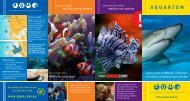Create successful ePaper yourself
Turn your PDF publications into a flip-book with our unique Google optimized e-Paper software.
<strong>Leeuwin</strong> <strong>Current</strong><br />
The <strong>Leeuwin</strong> current is the longest continuous coastal current system in the world. It<br />
originates near Western Australia’s North West Cape and flows southward towards Cape<br />
<strong>Leeuwin</strong> before turning eastwards into the Great Australian Bight. Along your journey<br />
through AQWA today you will trace the movement of the <strong>Leeuwin</strong> current from the Great<br />
Southern region to its origin in the Far North, and follow the signs to find examples of the role<br />
the current plays in the distribution of marine life along the coastline of Western Australia.<br />
What impact does the <strong>Leeuwin</strong> current have on the marine environment of Western<br />
Australia? What type of marine life is affected?<br />
Great Southern - Augusta<br />
Type of marine life: _________________________________________________________<br />
Effect of <strong>Leeuwin</strong> <strong>Current</strong>: ____________________________________________________<br />
________________________________________________________________________<br />
Shipwreck Coast - Kirki Oil Spill<br />
Type of marine life: _________________________________________________________<br />
Effect of <strong>Leeuwin</strong> <strong>Current</strong>:____________________________________________________<br />
________________________________________________________________________<br />
Marmion Marine Park - Marine ARC Turtle Pool<br />
Type of marine life:_________________________________________________________<br />
Effect of <strong>Leeuwin</strong> current: ____________________________________________________<br />
________________________________________________________________________<br />
Coral reef (Rottnest Island)- Unique Mix<br />
Type of marine life: _________________________________________________________<br />
Effect of <strong>Leeuwin</strong> <strong>Current</strong>: ____________________________________________________<br />
________________________________________________________________________<br />
In general, how does the <strong>Leeuwin</strong> current contribute to the diversity of marine life found off<br />
Perth?___________________________________________________________________<br />
________________________________________________________________________
Sand<br />
Not only is sand made up of ancient coral reefs, old shells, eroded rocks and the crushed up<br />
skeletons of crustacean but it is alive with micro organisms and home to a multitude of marine<br />
life. Burrowing is a common strategy used by animals to both hide and resist the pressure of<br />
ocean currents. On your journey along the coastline of Western Australia look out for<br />
information on the following animals and write down how each of them interacts with the sand.<br />
Perth Coast - Alkimos<br />
Slipper Lobster: ____________________________________________________________________<br />
________________________________________________________________________________<br />
Perth Coast - Scarborough<br />
Blackspot Goatfish: ________________________________________________________________<br />
________________________________________________________________________________<br />
Perth Coast - Cockburn Sound<br />
Snake Eel: _______________________________________________________________________<br />
________________________________________________________________________________<br />
Perth Coast - Cockburn Sound<br />
Tube Anemone: ____________________________________________________________________<br />
________________________________________________________________________________<br />
Far North - Mermaid Reef<br />
Seacucumber:_____________________________________________________________________<br />
________________________________________________________________________________<br />
Far North - Coral Lagoon<br />
Dwarf Hawkfish: ___________________________________________________________________<br />
________________________________________________________________________________<br />
Marmion Marine Park - Mettam’s Touch Pool<br />
Western Stingaree: _________________________________________________________________<br />
________________________________________________________________________________<br />
Marmion Marine Park - Stingray Bay<br />
Stingrays: ________________________________________________________________________<br />
________________________________________________________________________________
Fish Shapes<br />
Not all fish look the same!<br />
Complete the picture of a Seadragon and then compare its fins and body shape to that<br />
of the Skipjack Trevally.<br />
Seadragon<br />
Skipjack Trevally<br />
List some of the major differences between the shapes of the two fish<br />
• __________________________________________________________________<br />
__________________________________________________________________<br />
• __________________________________________________________________<br />
__________________________________________________________________<br />
• __________________________________________________________________<br />
__________________________________________________________________<br />
Which fish do you think could swim the fastest and why?<br />
_______________________________________________________________________<br />
_______________________________________________________________________<br />
_______________________________________________________________________<br />
What is the importance of the Seadragon’s leafy appendages?<br />
_______________________________________________________________________<br />
_______________________________________________________________________<br />
_______________________________________________________________________
Coral Reef<br />
1. What are the 3 water conditions that effect what shape a coral will grow?<br />
D_________ Hint: this is to do with positioning in the water.<br />
C_________ Hint: this would affect how far we could see in water.<br />
S_________ Hint: this is to do with movements in the water.<br />
2. Name the 4 common SHAPES used to describe hard corals:<br />
Mo______ Br_______ Pl______ Va______<br />
3. Which is the: weakest shape? ______________ strongest shape?_______________<br />
4. How do daisy corals and other soft corals find food?<br />
____________________________________________________________________<br />
5. How is this different to how hard corals get food?<br />
____________________________________________________________________<br />
____________________________________________________________________<br />
6. How does coral reproduce and how often does it occur?<br />
____________________________________________________________________<br />
____________________________________________________________________<br />
7. How do corals defend their territory? Name two different mechanisms.<br />
a)_______________________________________________________________<br />
b) ______________________________________________________________<br />
8. How do coral reefs create marine biodiveristy?<br />
_____________________________________________________________________<br />
9. What are the traditional indigenous place names for Fremantle and Rottnest?<br />
_____________________________________________________________________
Where am I?<br />
Can you use the clues below to identify what AQWA region you are in?<br />
• The coastal landscapes are as ancient as the earth itself.<br />
• Some of the animals that inhabit this region can reach over 7m in size!<br />
• Animals lie motionless on the bottom ready to ambush any passing prey.<br />
I’m in AQWA’s _________________________________ region.<br />
This region covers the latitudes of ________ to _________ O South<br />
• Huge granite shores have been shaped by massive waves from the icy waters of Antarctica.<br />
• In Oyster Harbour indigenous locals caught fish using stone traps instead of hooks.<br />
• Animals cling to jetty pylons and fish bury themselves in the sand below.<br />
I’m in AQWA’s _________________________________ region.<br />
This region covers the latitudes of ________ to _________ O South<br />
• In these temperate waters you can find limestone reefs which have both supported and<br />
threatened life.<br />
• Cold water from Antarctica mixes with warm water brought down from the tropics by the<br />
<strong>Leeuwin</strong> <strong>Current</strong>.<br />
• Animals may hover above the seafloor.<br />
I’m in AQWA’s _________________________________ region.<br />
This region covers the latitudes of ________ to _________ O South<br />
• Nutrients from the land travel out the river and mix with the salt water of the Indian Ocean<br />
creating a rich region of marine life.<br />
• The reefs of today are often the submerged sand dunes of yester year.<br />
• Animals hide in caves or drift with the ocean currents.<br />
I’m in AQWA’s _________________________________ region.<br />
This region covers the latitudes of ________ to _________ O South





